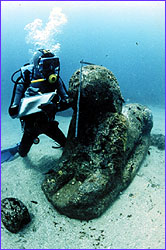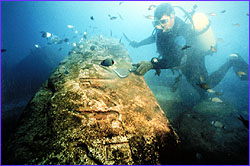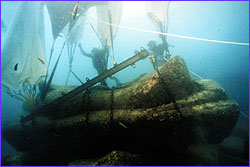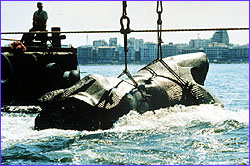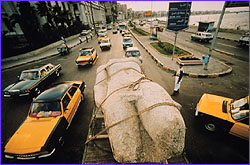|
|
|
|
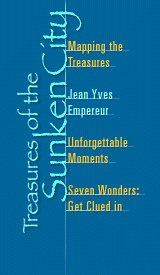 |
Jean Yves Empereur: The Riches of Alexandria
NOVA: Apparently it has been known since the time of Napoleon Bonaparte that there were interesting artifacts underwater in the harbor of Alexandria. Can you tell us why the area was not investigated fully until '94? Empereur: There are several reasons. The first one is that the regulator was invented by Cousteau in 1943. And so before it was difficult to proceed with underwater excavations. And it's only in the early '50s that Cousteau himself began to do underwater archaeological excavations. In Alexandria during the Second World War it was a little bit difficult to dive, because there was a continuous state of war. The area was continuously occupied by the Egyptian Marines. And you have to get a lot of permits to be able to dive, and it's somewhat difficult to get these permits. The Northern coast of Egypt is difficult for diving. NOVA: I understand that much of the ancient city of Alexandria has been lost through centuries of building. Were the objects in the harbor protected from that development and does that make this site particularly important? Empereur: What is interesting underwater is that there is no construction. When we make rescue excavations in the city on land, once a year an old building, a cinema, a theater or a storehouse comes down, to build a new tower of offices. What we see is occupied from just now until ten meters (33 feet) down with all the states of occupation of the city. So Mamluk, Byzantine, Roman, Greek and so on. In the water it's completely different. It's protected from antiquity until now. There was no more recent occupation. And so we find exactly the state from antiquity—without new occupation—and that's really interesting.
Empereur: Of course. They're from more than 2,500 architectural pieces. And we believe that most of them—about 99 percent of them—belong to other monuments of the city. For instance there are some sphinxes, some obelisks, some columns, which belong to other monuments of the city. But what we think belongs to the lighthouse itself—it's only a very few, a dozen of the architectural pieces, which are more than 70 tons. But we believe that these few elements were very difficult to move them the place where they collapsed from the lighthouse itself. NOVA: How did the lighthouse wind up under water? Empereur: From the fourth century until the 14th century there were earthquakes in Alexandria. In the Arab sources alone you have more than 20 mentions of earthquakes which affected the lighthouse. And we know that in the 14th century, after the Arabs had made some repairs to the lighthouse, the lighthouse collapsed due to very severe earthquakes. There is a map in Montpelier, a town in southern France, which indicates that in 1303 the lighthouse of Alexandria was destroyed. In fact, there is an Arab traveler, his name is Ibn Battuta, who came to Alexandria in 1326 for the first time. And he writes, "I could have access to the door of the first floor of the lighthouse." And when he comes back to Alexandria in 1349, he says, "No access to this door. Everything here has collapsed." So in fact, in the first half of the 14th century that very strong earthquake put an end to this tower. This earthquake made the lighthouse collapse in a kind of line from the seashore. And we found a dozen fallen pieces under the sea in a line. Some of these pieces were in fact broken in two or three fragments, each of which is about 20 or 30 tons. NOVA: Did you use your map to help you figure out which piece came from the lighthouse?
NOVA: Have you found any Greek lettering on any of the blocks, or just Egyptian hieroglyphs? Empereur: We have found only one marble piece which bears alpha, rho, tau, sigma and omega—five letters in Greek. In fact, it was a very huge inscription, because the letters are more than 30 centimeters high and were in bronze. We found only the traces of these letters with holes in the marble. With five letters it's difficult to complete the inscription and to have an idea of the general text. But there is an American scholar who wrote an article about this inscription. And he made a restoration of the wall text, saying that, in fact, we discovered the inscription of the lighthouse itself. NOVA: Are most of these blocks dated to the same time, or do you not know that? Empereur: Yes, we know that they belong to the Greek time. For instance, the colossal statues which stood at the foot of the lighthouse itself, we are certain that they are portraits of King Ptolemy. And what's interesting is that these Greek kings chose to be represented as pharaohs. That means that they were not only the masters of the Greek city of Alexandria, but of the whole country named Egypt. Every captain, every traveler entering the harbor of Alexandria was obliged to pass in front of the statue of the kings and queens—the kings as pharaohs, and the queens as the Goddess Isis. It was a kind of royal propaganda. NOVA: We've heard that 26 sphinxes have been found in the harbor. What are all those sphinxes doing there? Were they part of a monument or were they thrown out?
And all the 26 sphinxes we have found up to now are very different, belonging to different pharaohs, different by size, different by even the material—some come from granite, some from quartzite and so on. And so they do not belong to a row of sphinxes like in Luxor or in Karnak. In fact, they all come from Heliopolis, which is north of Cairo and was destroyed at the time of the Greek Ptolemies. This very old pharaonic sanctuary was used as a quarry. They took from it obelisks, sphinxes, and all kinds of pharaonic pieces to use in Alexandria. Some of them were used as decoration for the city as obelisks or sphinxes. Others were used as building materials. Some of these obelisks or sphinxes were used in Rome or in London or even in New York. The obelisks of Central Park near the Metropolitan Museum, in fact, come from Alexandria. NOVA: Now that you have removed a lot of artifacts from the harbor, do many still remain? And can people go to Alexandria and dive to see them? Empereur: Yes, there is a plan by the Egyptian authorities to transform this archaeological site into an archaeological park. And to let people dive and have a look at these antiquities underwater. First they'll have to fix the sewage problem. Then we have to complete, of course, the excavation, which should be in the fall of '98. The third point is that they have to transform this Qaitbay Fort into a lighthouse base and a lighthouse museum, to let people rent suits and so on for diving. So I think that you have to wait a little bit more, for say two, three, four years to get this park ready for amateur divers, so they can have an idea of this very impressive site. NOVA: Do the blocks need to be protected in any special way once they come out of the water?
NOVA: We've heard that there are Greek and Roman shipwrecks not far from where the lighthouse was found. Can you tell us more about that? Empereur: Yes. This is a new discovery we made last November. We knew from ancient sources that the entrance of the harbor of Alexandria was very dangerous. This is due to the rocks which are at the surface of the water, or just below the surface. In fact, we discovered from 300 meters from the coast to 2 kilometers from the coast some Greek and Roman shipwrecks, from the 4th century B.C. until the 7th century A.D. This is a very new and rich documentation on the trade of Alexandria with the rest of the Mediterranean. NOVA: What are your plans for working there? Empereur: We are doing a survey now to make a new map on this zone. And now we have a map which is in progress, with anchors, with these shipwrecks, and so on. For several months we have been excavating one of these shipwrecks. This shipwreck is the cargo of an Italian ship from the 1st century B.C., around 50 B.C.—the time of Caesar. These shipwrecks are full of wine amphoras imported from Greece, from northern Turkey or from Italy, Spain, North Africa. And even some plain pottery and fine pottery lamps, and you can even find the anchors of the ships. NOVA: How many shipwrecks do you hope to find? Empereur: We don't know exactly, because this work is in progress now. But so far we have more than one dozen such shipwrecks, and I think perhaps that there are many, many more. NOVA: It sounds like your plate is full. Empereur: Of course, but you are running from one place to another, and it's a pity that there are no more archaeologists working in this field, to collaborate, to save more of the antiquities of this capital of Ptolemies. NOVA: Well, thank you very much for your time and good luck with the shipwrecks and everything else you are working on. Empereur: Thank you very much. See you in Alexandria one day I hope. Mapping the Treasures | Empereur | Unforgettable Moments Seven Wonders | Resources | Guide | Transcript | Treasures Home Editor's Picks | Previous Sites | Join Us/E-mail | TV/Web Schedule About NOVA | Teachers | Site Map | Shop | Jobs | Search | To print PBS Online | NOVA Online | WGBH © | Updated November 2000 |
